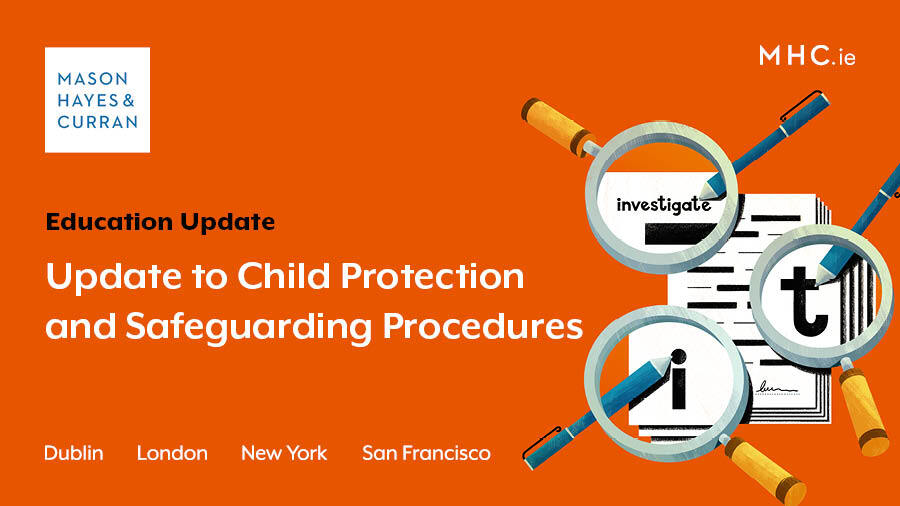Update to Child Protection and Safeguarding Procedures

The Department of Education has provided an update to the Child Protection and Safeguarding Procedures. This update includes stand-alone procedures for boarding facilities associated with recognised schools. It places significant emphasis on the management and governance of boarding facilities. It is important for all schools and boards of management to take notice of these important updates.
Key changes to the Procedures for all schools
One of the key changes to the Procedures is that all records relating to staff members and children, where a report has been against them, are anonymised. However, the staff member should be provided with a unique code which must be re-used if there are further allegations made against them.
The Procedures require the Board of Management to notify the Teaching Council once a teacher stands dismissed from 11 May 2023 onwards, or has resigned following the making of a complaint or the invoking of a disciplinary process.
Records provided to the Board of Management must be anonymised and suitably redacted to ensure the identities of any children and other parties are not disclosed. Copies of the following documents and records must be redacted and anonymised:
- Copies of all records and notes in relation to how the allegation came to be known to the Designated Liaison Person (DLP)
- Copies of any records and notes in relation to the seeking of Tusla advice concerning the allegation and the advice given
- Copies of any report submitted to Tusla in respect of the allegation
- Copies of any other records of communications with Tusla, An Garda Síochána or any other party regarding the allegation. This includes any acknowledgement of receipt of the report by Tusla
- Copies of any notification issued under section 5.6 of the Procedures – where a parent of a pupil makes an allegation of abuse against a member of staff.
- Copies of any statement provided to a member of school personnel under section 5.3.8 of the procedures.
New procedures for boarding facilities
The DLP
Boarding facilities may operate both under the governance of a Board of Management of a recognised school, and/or a separate management authority that is not subject to oversight by the Board of Management. The management authority of the boarding facility must appoint a senior full-time person as the DLP for the boarding facility and a stand-in or deputy DLP. The deputy will assume responsibilities in the absence of the DLP. Both must be contactable at all times. Where there is a DLP appointed for the school and the boarding facility, arrangements must be in place to ensure communication between the DLPs are within the limits of GDPR. It is important to note that where a concern is raised regarding a DLP, different reporting mechanisms must be employed.
After-school activities or services
The Child Protection Procedures for Primary and Post-Primary Schools requires that after-school activities and services have adequate child protection measures and clear procedures for reporting any concerns that arise within the activity or service. To ensure compliance with the Children First Act 2015, the school must conduct a risk assessment and display a Child Safeguarding Statement specifying the risks of harm identified. The risk assessment must also set out the procedures that are in place to manage those risks.
Policies and procedures
A management authority should have regard to the various policies and procedures varying from vetting and training to appointment of student leaders, to ensure compliance with the 2015 Act.
- Child Safeguarding Statement - Significant emphasis has been placed on the requirement for boarding facilities to develop a Child Safeguarding Statement. Accordingly, the statement should outline the policies and procedures which are in place to manage risks associated with a boarding facility. Once developed, the statement must specifically name the DLP, be displayed in public spaces and communicated to parents/guardians, staff, and students. The statement must be reviewed annually or following amendments that are subsequently introduced. The procedures provide a helpful checklist for boarding facilities in determining whether they have considered a number of risks associated with boarding facilities (e.g. younger students being in unsupervised company of older boarders, initiation activities, emotional vulnerability, weekend arrangements, inter-personal relationships and substances).
- Vetting and recruitment - All individuals working with children and vulnerable persons must be vetted by the National Vetting Bureau before commencement of their employment. Accordingly, there must be robust procedures for checking references and suitability of all staff prior to the commencement of their employment. Moreover, there must be procedures in place to enable management authority to identify child protection and safeguarding problems, ensure employees understand the child safeguarding and protection procedures (CSPS) and associated responsibilities.
- Training - All personnel and members of the management authority must be made aware and understand the CSPS procedures to enable them to fulfil their responsibilities. Tusla has a training module that is recommended to all personnel. The obligation to comply with the 2015 Act extends to all professionals, including registered teachers. A list of mandated persons should be maintained and made available by the management of the boarding facility.
- Student leaders - Where student leadership roles exist, the management authority should have a code of behaviour setting out the boundaries and responsibilities associated with the role and provide age-appropriate training prior to appointing any student. Students should be made aware of the Child Protection and Safeguarding Policy and reporting procedures in the event of breaches by other students or staff. Lastly, all students and parents/guardians should be encouraged to articulate their opinions about their boarding experiences and accessible systems for students to raise concerns regarding child protection and safeguarding.
Comment
The aim of the CPSP Procedures is to ensure there are effective systems in place for students, parents/guardians, and staff to raise concerns regarding child protection and safeguarding and processes of how it will be addressed.
Accordingly, it is necessary that boarding facilities have ensured that:
- Clear management roles and responsibilities have been established.
- All personnel are vetted and have been made aware of their responsibilities to ensure the safety and protection of children. Management authorities may be required to provide a declaration demonstrating compliance.
- Clear policies and systems for reporting are displayed and communicated to all students, parents/guardians, and other personnel.
- Training is provided to all student leaders, personnel of the management authority and other members of staff regarding the protection and safeguarding of children.
For more information, please contact a member of our Education team.
The content of this article is provided for information purposes only and does not constitute legal or other advice.
Share this:




